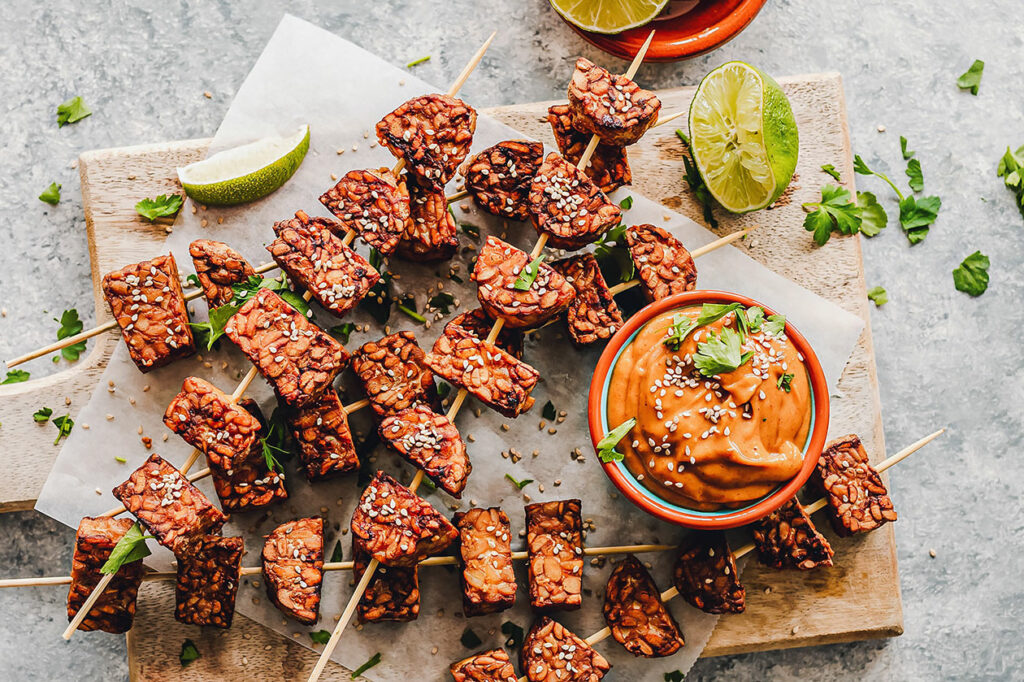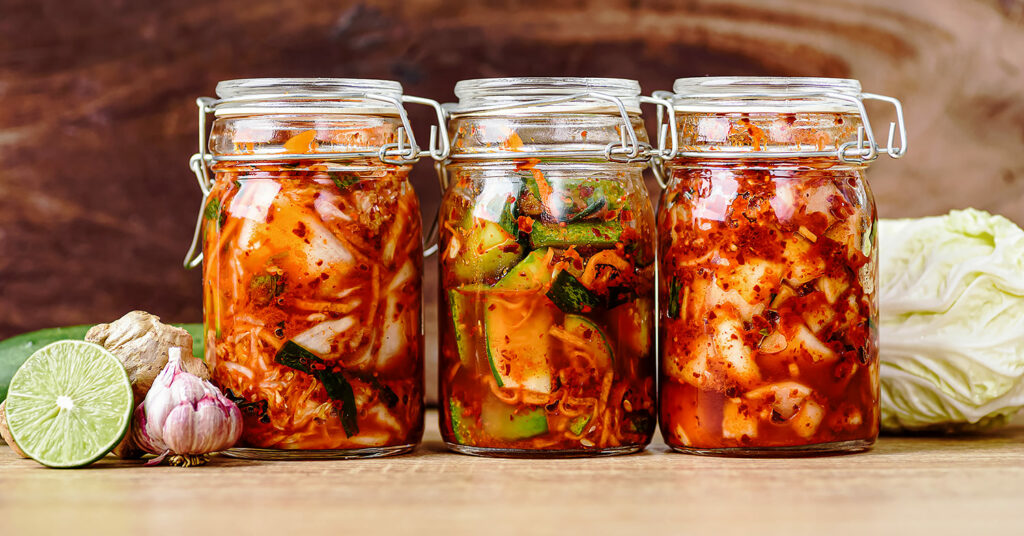Culinary trends come and go, but it seems like fermented food’s popularity is here to stay. Fermented food is easy to buy and simple to make—plus, it’s delicious, nutritious, and can help reduce kitchen waste. So, whether you’re a die-hard sauerkraut enthusiast or a curious novice, you might be wondering what the fermentation process actually involves. How does the science work? And is fermented food and drink really as good for you as people say?
Natural fermentation dates back thousands of years to human prehistory, and some of the earliest evidence indicates that people have enjoyed fermented alcoholic beverages since at least 13,000 BC. But according to the outdoor museum Living History Farms, humans’ first forays into fermentation may go back even further than this.
Some of humanity’s early attempts aimed to preserve easily-spoiled food sources such as dairy would have resulted in natural fermentation, producing yogurt. It’s likely that North Africa was home to the first-ever yogurt makers, thanks to the region’s high temperatures and the microflora already present in goat, sheep, camel, and cow milk.
In general, fermented foods are a central part of human history, and people have used the science of fermentation to produce everything from beer to bean curd. Today, fermentation as a natural preservative could even help reduce the world’s food waste at an industrial level if transformed into new and shelf-stable fermented products such as sauces and snacks.
Furthermore, the Good Food Institute (GFI) has said that fermentation could become the third pillar of alternative protein production—revolutionizing the flavor, texture, appearance, and sustainability of plant-based meat, eggs, and dairy products in the coming years.

How does fermentation work?
The chemical process of fermentation involves the breaking down of one substance into a simpler substance via enzymes. In food and beverage manufacture, fermentation can refer to any use of microorganisms to bring about desirable chemical changes in ingredients.
This could describe the brewing of alcohol, the preserving of food, or the development of new flavors. This is because fermentation can alter the taste and nutritional profile of staple ingredients along with their longevity.
The fermentation process itself occurs with the introduction of beneficial microorganisms (such as bacteria and yeast) to an ingredient, alongside the removal of oxygen. Temperature also plays a critical role, though this varies from recipe to recipe (and sometimes region to region).
For example, the majority of modern, home vegetable fermentation requires some time at room temperature for the enzymes to get to work before refrigeration. This then slows the process down and allows for further safe storage.
French chemist Louis Pasteur (yes, the process of pasteurization is named after him) first discovered the connection between yeast and fermentation in the mid-1800s. He thereby created zymology, the science of fermentation, as we know it today.
At this time, the process was purely a way to preserve and extend the longevity of stored food. Experts would not recognize its various health benefits until the early 1900s when Russian bacteriologist Elie Metchnikoff noted the relative unusual longevity of Bulgarian citizens for the time (up to 87 years).

Is fermented food good for you?
Fermented food really is good for you, but the jury is still out on whether it can actually extend your life. As with all “health foods,” fermentation is not a cure-all—but it does give your stomach’s natural bacteria (and thereby your immune system) a nutrient-dense and delicious boost.
Some research indicates that fermented foods can have antimicrobial, anti-carcinogenic, anti-allergenic, and blood-pressure-lowering effects. At the very least, the probiotics (or “good” bacteria) contained in foods like kombucha help your body digest and absorb other nutrients.
There are approximately 100 trillion bacteria in a person’s intestinal system, and everyone’s microbiota is different. Humans’ relationship with this bacteria is symbiotic, and keeping your gut healthy (by taking exercise, avoiding stress, consuming less sugar, and eating probiotic foods) can have a direct, positive impact on your overall wellbeing, including mood.
Plus, fermented foods are rich in vitamins. Sauerkraut is high in fiber, iron, magnesium, calcium, and vitamins B, A, K, and C, while miso is rich in vitamins B, E, and K, plus folic acid and essential minerals.
In addition, fermented foods are simply easier for your body to digest. The fermentation process even makes ingredients such as soy and gluten (which many people have trouble digesting comfortably) more manageable. For example, tempeh is easier on the digestive system than processed tofu, and sourdough bread is better for those with a gluten sensitivity.

What foods can be fermented?
Simple fermentation techniques make preserving and flavoring fruit, vegetables, grain, nuts, and legumes easy. But there are a surprisingly large number of popular ingredients that already incorporate fermentation. In fact, you may have been eating fermented foods for your entire life without realizing.
One of the most popular foods of the moment is kombucha, a fermented tea-based drink that combines sugar with a symbiotic culture of bacteria and yeast (“SCOBY”). It’s a far cry from sauerkraut, but the naturally fizzy beverage has that distinctive tang of fermentation.
The probiotic drink originated in 220 BC Northeast China (Manchuria) and was popular for its perceived healing benefits and tart flavor, much like today. However, it’s worth noting that a lack of regulation and empirical evidence casts some doubt on some bolder claims.
For example, some say that kombucha can help tackle health problems such as arthritis and depression. While fermented foods can be nutritious—and a well-balanced diet undeniably supports health improvements—they are not a replacement for medical treatment.
Tempeh is another fermented product you may have consumed without realizing it. The traditional dish involves the inoculation of cooked soybeans with rhizopus mold to create a nutrient-dense loaf of mycelium. (Note: both miso and nattō use fermented soybeans and live cultures.) Tempeh originates from Indonesia and makes an easy swap for tofu and other plant proteins.
Modern brunch staple sourdough is actually the single oldest form of leavened bread in human history. Much like the creation of yogurt, the first sourdough starter may have been created by accident. Sourdough bread is delicious and comes with several benefits that conventional bread does not, such as a lower glycemic index and reduced gluten.

Can you do it at home?
DIY fermentation is simple, affordable, and satisfying. The easiest ingredients to ferment at home are fresh vegetables, as in dishes such as sauerkraut (cabbage and caraway seeds), kimchi (cabbage, radish, and spices), and beet kvass (beets, raisins, and sugar).
Lacto-fermented fruit and lacto-fermented veggies are also simple to make. They rely on naturally occurring lactobacillus bacteria for fermentation and taste tangy rather than vinegary. Fermented fruit is both sweet and sour, a perfect accompaniment to desserts, yogurt, and smoothies.
Sterilized jars, your desired fruit or vegetables, salt, and spices, are all you need for basic home fermentation. You can sterilize jars easily by washing and then drying them in a preheated oven for 15 to 20 minutes, or by boiling them thoroughly on the stove.
Cut your ingredients into small, even pieces, as preferred. For sauerkraut, many recipes suggest a salt rub to start off the cabbage. Once the shreds have separated from their own brine, it’s time to stir through the spices and place the mixture in jars. Remove all the oxygen by topping with cling film or a piece of parchment paper.
To learn more about fermenting (and pickling) at home, check out LIVEKINDLY’s in-depth guide here. To find out about the need to prevent unnecessary food waste, read on here.


